The cat killer stalking suburbia
- Published
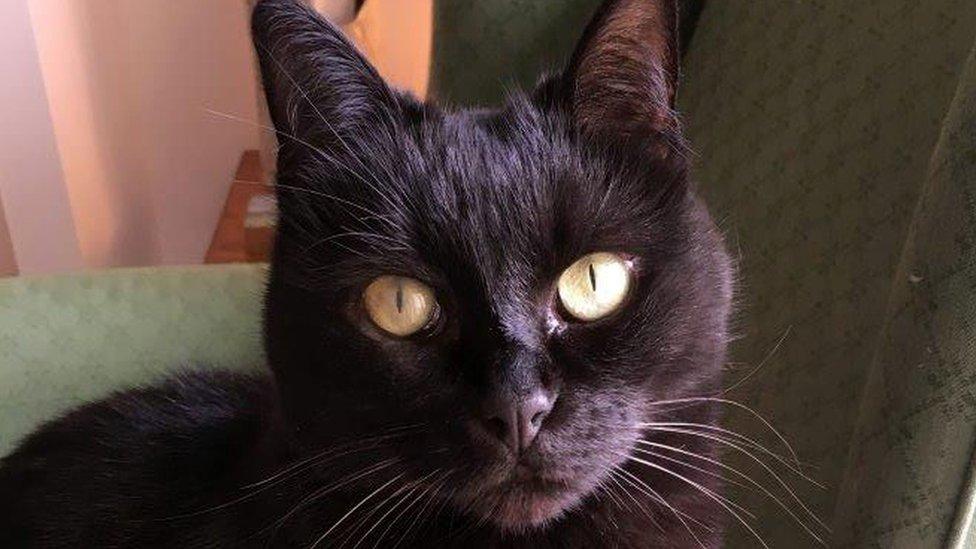
Scooter
For the past two years, a serial killer has been attacking pet cats in Britain, leaving behind him a trail of fear and mistrust.
This story contains details some readers may find distressing
Exactly what happened to Chantelle's black-and-white cat, Scooter, is a mystery.
The last time she saw her, they were in her kitchen on a warm, still night this summer. Scooter was sitting on a stool watching as Chantelle marched around the house to increase her step count before bed. The next morning, she had disappeared.
As Chantelle searched the street outside, a neighbour came over to say he had found Scooter at 1am. She had been lying dead on the pavement outside his house. He thought she could have been hit by a car, even though there was never much traffic in their residential street.
He told Chantelle he had gone inside to find a blanket to cover the body. When he returned it had disappeared. He assumed foxes had taken it.
But later that day another neighbour approached Chantelle to tell her she had also found Scooter.
This time the dead cat had been seen at 5.30am on the neighbour's front lawn. Scooter had been laid out as if she was stretching, except her tail had been removed with a clean cut and she had been sliced open from head to abdomen. Her entrails had been pulled out and laid beside her on the grass.
The second neighbour had called the local council to take the body away, so Chantelle didn't see it with her own eyes. But she was was sure of one thing - Scooter's death was not an accident.
Chantelle had read stories about a cat killer operating around the M25, a motorway that forms an outer ring road around London. She didn't think her own cats would be in danger in her home in St Leonards-on-Sea, 70 miles away on Britain's south coast.
"I didn't think to lock my cats up at night, but if I had, Scooter would still be alive," she says.
She and her husband are now thinking about moving to a new house where they can secure the garden to prevent their other cat getting out.
"I've had a couple of miscarriages and that was easier to deal with than this because that was meant to be," says Chantelle.
"I've never been jittery in my entire life, and now he's messed up the tranquillity we had."
The person Chantelle thinks is responsible for Scooter's death is a prolific cat killer who has been operating in Britain since 2015.
During that time he - and police are sure the killer is a man - has butchered more than 370 animals, mostly pet cats, but also foxes, rabbits and possibly a wild, baby owl.
The first reported victims were clustered around Croydon in South London - so the press named him the Croydon Cat Killer.
Sorry, your browser cannot display this map
Map produced by the BBC data team using Carto.
But killings were later reported all around London, prompting a second nickname, the M25 Cat Killer.
In fact, his hunting ground has spread even further than this - to the Isle of Wight, Kent, Birmingham, Wirral and Sheffield.

In early June, a small group of people gathered in a Quaker meeting hall in Croydon by the side of a busy roundabout.
As the traffic hummed and beeped outside, the group listened to a harpist and lit candles on a table adorned with a large photograph of a tabby cat with a white tummy.
They were there to commemorate the animal victims - joining together to sing the hymn All Things Bright and Beautiful and to recite poems about grief.

"Love will solve this," was the reassurance given by the organiser, a 46-year-old local animal activist with the striking name, Boudicca Rising.
Over the past two years, Rising and her partner, 52-year-old Tony Jenkins, have been the central characters in the hunt to catch the cat killer - real-life pet detectives.
Originally from South Africa, Rising is a self-described "mad cat lady" who has been involved in animal rescue since arriving in Britain in 1994.
When she and fellow animal-lover, Tony, became a couple five years ago, they set up their own animal protection charity named after their neighbourhood - the South Norwood Animal Rescue and Liberty, or Snarl.
In 2015, as reports filtered in of pet and fox deaths in South London, Boudicca and Tony first wondered whether a gang was responsible.
"The previous work I've done has been around animal crush videos, which is sexually motivated animal torture," says Boudicca, referring to the market on the dark web for graphic videos of live animals being crushed to death.
"But as time went on we realised we were probably dealing with a serial killer," she says.
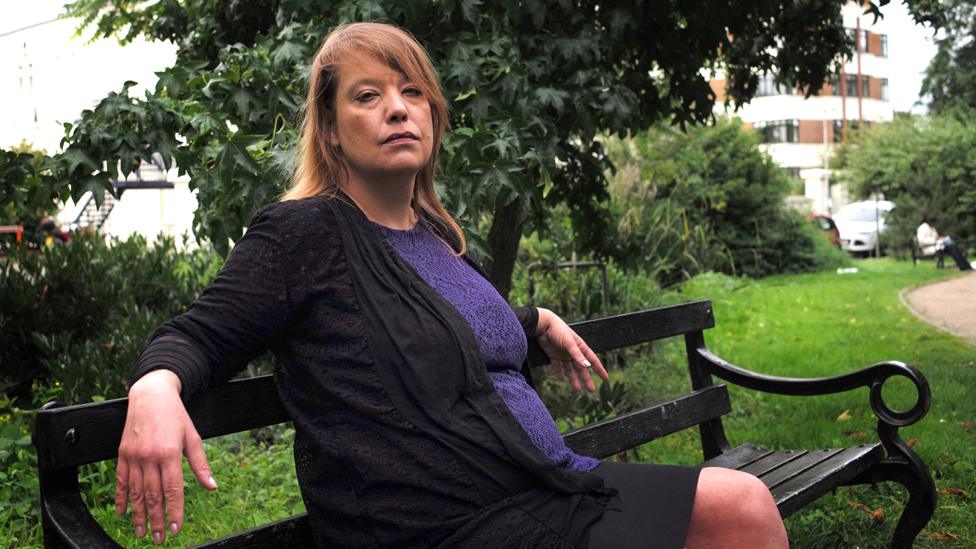
Boudicca Rising has been investigating the cat killings for several years
Boudicca and Tony are now officially collaborating with the Metropolitan Police in Croydon who have set up a special task force named Operation Takahe (the operation name was generated randomly and happens to be the name of a near-extinct, flightless bird in New Zealand).
It was Snarl who persuaded the police to get involved, providing details of killings and speaking out at a 2015 Croydon community meeting attended by the then head of the Metropolitan Police, Sir Bernard Hogan Howe.
"I understand some people may scoff at this," says the man running the operation, Det Sgt Andy Collin.
"But the loss that owners are feeling is very real."
Snarl now operates a triage service for the police.
They urge anyone who has found a body to call them first as they have a checklist to establish which deaths were caused by the killer, and which were caused by road accidents or other acts of cruelty.
When a victim is found, they help secure the crime scene, check the animal's microchip and scour the ground for evidence.
In some cases, like that of Chantelle's cat Scooter, they arrive too late and the bodies have already been removed by the council. But when they can retrieve remains, Snarl has helped pay for post-mortems to confirm the cats were killed by the same person.
"It's important for us to deal with the cases that are clearly linked," says Andy Collin.
"It's quite possible other people have got on the bandwagon - copycats if you like."

The killer has struck in residential areas in secluded paths and alleyways behind terraced houses
Snarl's work has helped to build up a picture of the killer's methods.
He strikes mainly at night in residential areas, often luring his victims with pet food, crab sticks or raw chicken. He kills them quickly with some sort of blunt force then waits at least half an hour for their blood to coagulate before mutilating their bodies.
He has cut off heads, paws and tails as well as sliced victims open. Often no blood trail is left, indicating that the victim is cut up in a different location. He then tends to display the bodies close to where he's hunted them down, sometimes in public spaces such as playgrounds. He's also been known to attack twice in the same area.
"I think there's an element of disbelief," says Boudicca of the reaction to the macabre brutality of the attacks.
"There are people out there who would rather believe anything else is happening rather than this."
This disbelief has manifested itself in angry posts on Snarl's Facebook page. Arguments have erupted between those who accuse Snarl of exaggerating the problem, saying the cats have been killed by foxes or in accidents, and those who are angry and want revenge against the killer.
"We have trolls on our page, sniping," says Boudicca, who has been accused by some of these hostile visitors of misappropriating funds and lying about the scale of the problem.
"But I think it's helpful to show the anger - I don't want communities withholding it as that won't end well."
But as well as attracting critics, Snarl has also gathered supporters especially around London, where volunteers distribute leaflets. Some of these attended the memorial service in June.
"So many people still don't know there's a cat killer," says Julie, who is a regular leafleter.
Julie does not want to give her full name, or even say where she lives, as she's afraid she may become a target herself. And she says the unease and distrust in the community is so great that some believe the killer could be hiding in plain sight among them.
"We haven't ruled that out," she says.
"We hope not, but we haven't ruled it out."
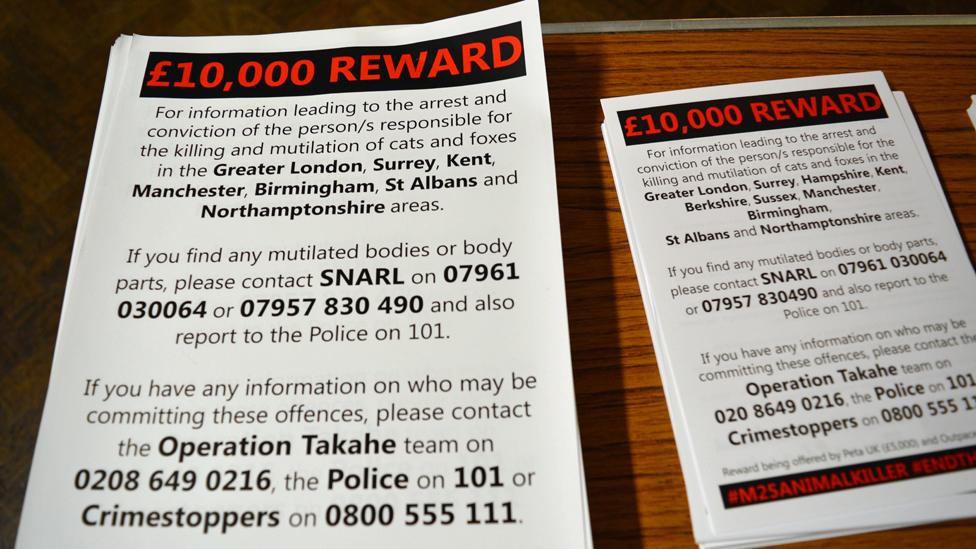
Serial killers often begin their careers by harming animals.
Andy Collin, the police detective, fears it is only a matter of time before the UK cat killer turns his attention to humans.
A profile drawn up by the National Crime Agency suggests that the killer's problem with cats stems from a deeper problem with women, or with one woman in particular.
"Cats are targeted because they are associated with the feminine - the killer can't deal with a woman or women who are troubling him," says Collin.
"The concern we have is that if it isn't a particular person - who will be at some risk eventually - then at some stage he'll escalate or feel brave enough to move on to vulnerable women and girls, either elderly or very young women."
Collin says that, if caught, the killer will probably be charged with criminal damage, though he's hoping to prosecute for other, more serious offences.
"If an animal is despatched humanely then you haven't necessarily got a cruelty offence," says Collin. The charge of outraging public decency could cover the psychological harm inflicted.
By his own admission, the detective is "massively frustrated" by his inability to catch the killer.
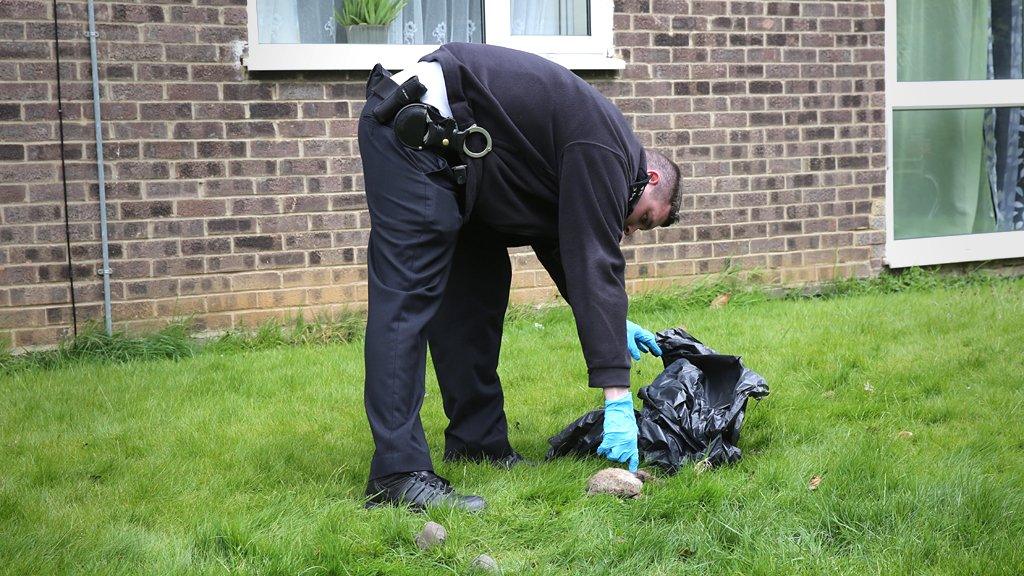
The police have been investigating the animal killings since 2016
In August this year, his team released details of a man described as a "person of interest" after witnesses chased a man who was seen close to the site of an attack in Caterham, south of London. There was also a second possible sighting in nearby Orpington.
He was described as a man in his 40s, with short brown hair, dressed in dark clothing with possible acne scarring to his face, wearing a headlamp or carrying a torch.
"It's promising, but it's not something I would put a lot of money on," says Collin.
The fact that the majority of attacks have taken place in quiet resident areas hasn't helped him.
"We're always told we live in the most covered CCTV society in the world," says Collin.
"But when you go into suburban streets, while there might be cameras, people concentrate them on their own properties."
Nor have there been leads from forensic evidence.
It's almost impossible to gather DNA from cat fur, and even if his team managed to collect some, Collin says it wouldn't necessarily be from the killer.
He suspects the killer must wear gloves as no skin has been found under the claws of the victims. But even this detail isn't much help.
"If you're out at night, the chances are you'll have on a pair of gloves," he says.
"It's not likely you're walking around with a great big banner above your head."
One area where the police have made progress is in drawing up a geographical profile of the crimes.
Addiscombe - on the outskirts of Croydon - has been identified as an anchor point from where the offences started. The suburb, like many in which the killer has struck, has a run of secluded paths and alleyways behind its terraced houses, making it easy for someone to enter and leave gardens unnoticed and slip away into the night.
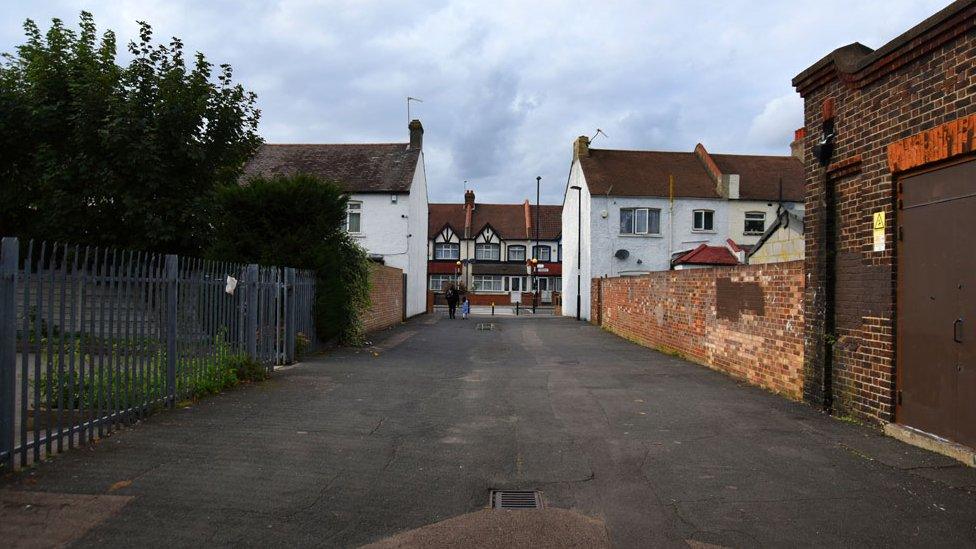
The trail leads to Addiscombe, south of London
"There is something about Addiscombe that links quite strongly to our person," says Collin.
"It could be a family house from the person's youth, a gran's house, or somewhere they're living now. Somewhere they've stayed in and feel comfy in, or somewhere they've gone to school."
In September, Britain's first forensic laboratory dedicated to prosecuting crimes against animals announced it would re-examine the bodies of dozens of cats believed to be victims of the killer.
The laboratory, based at the University of Surrey, is described as a CSI for animals.
"We're looking at various different elements of this case at the forensic level - work that hasn't been done before," says university spokesman Dave Ferguson.
The news is welcomed by Naomi, who has allowed the body of her cat Ivy to be stored in a freezer for 15 months in the hope that a re-examination might help bring justice.
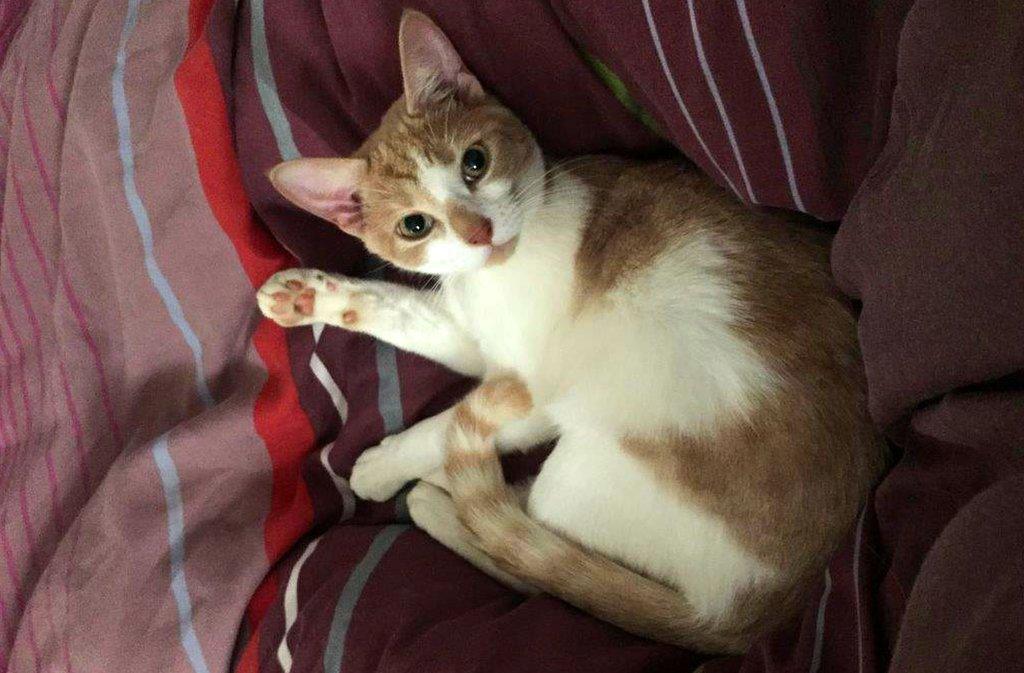
Ivy
Naomi remembers the morning that Ivy failed to come in to her home in Northamptonshire when she was called for food.
She immediately searched her neighbourhood on foot, before jumping in her car to conduct a wider sweep.
Within minutes, she had found Ivy's decapitated body discarded by the side of a busy road.
"I was very emotional. I couldn't stop crying," she says. Although she searched for Ivy's head, she wasn't able to find it.
Naomi had to take three weeks off work with depression and anxiety. She says she still struggles with nightmares and interrupted sleep.
She now locks in her other cats at night and comes home early from evenings out to make sure they're safe.
"A cat being hit by a car you can accept as an accident," she says.
"This is completely different. It's caused so much pain, and a feeling of anger."
Boudicca Rising says she hopes that stories like Naomi's and Chantelle's will help people understand the emotional toll that the killer has inflicted, and perhaps prompt more witnesses to come forward.
"Our problem is that people still think of him as just the Croydon cat killer, even though he's been more widespread for some time," she says.
"I hope people realise they need to keep their cats indoors, keep a look out for strange behaviour and report it to the police.
"Most of all I hope that somebody will recognise his characteristics and the places he's killed - and turn him in."
Photographs by Emma Lynch and Joanna Jolly
Photographs of cats courtesy of their owners
Join the conversation - find us on Facebook, external, Instagram, external, Snapchat , externaland Twitter, external.
